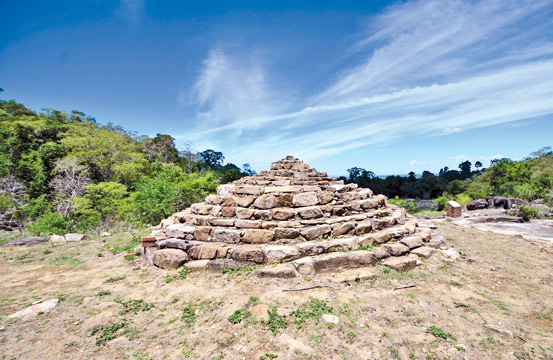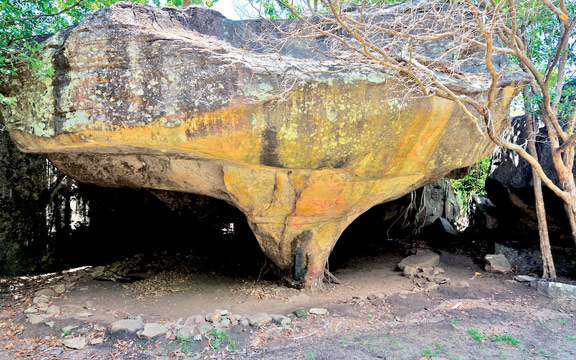 Rajagala:
Where time stands still Rajagala:
Where time stands still
Story and pictures by Mahil Wijesinghe
It is a busy morning as several groups of labourers, under the
watchful eyes of a team of archaeologists, shovel out soil,
painstakingly revealing the buried ruins, re-construct a ruined stupa,
restore a buried Bodhigara (Bo tree enclosure) and align the unearthed
stone slabs in the vast rectangular area. Though a typical work, this is
a usual sight at the Rajagala archaeological site these days. And I am
heading there, to witness first hand history being unearthed and legend
being given new life.
Rajagala, an awe-inspiring mountain range, known as Rassahela in
ancient times, lies 25 kilometres north of Ampara, in the village of
Bakkiella. The ruins here are that of the ancient Girikumbhila Viharaya,
said to have been a great monastery patronised by kings and princes of
the Ruhuna Kingdom, in the long ago days.
The history of Rajagala dates back to the early days of Buddhism and
the arrival of Arahat Mahinda. An inscription found amidst the forest
growth reveals that the ashes of Arahat Mahinda and one of his
disciples, Itthiya, were enshrined in a stupa at Rajagala.
Ruins and monuments
However, historical records reveal that Rajagala gained in
significance during King Kavan Tissa's reign of Digamadulla (presently
Ampara), and later during the reign of King Saddha Tissa and his son
Prince Lanjatissa.
|

Stone bowl (Gal Paaththaraya) receptacles that were used to
store water |
Prince Lanjatissa, it is recorded, had continued his patronage even
after he ascended the throne of Raja Rata, transforming Rajagala
hermitage into a one of the greatest monasteries in Ruhuna.
Reaching the ruins is quite a challenge. At the foothill of Rajagala
is a small office of the Department of Archaeology, from where you have
to get permission to trek the rest of the way, and of course directions.
The route, though pretty is tough going, up some steeply inclined stone
steps cut into the boulders.
On our way up, we spotted a giant squirrel sprawled on a tree branch,
fast asleep. The chirping of birds accompanies us as we climb up the
stone steps. It takes about an hour of climbing to reach the summit, but
the effort is worth it, for the view from up there is indeed 'wow'
worthy.
At the summit, the main path branches off into two directions, one
leads to the northern slop, where many ruins and monuments lie and the
other to the eastern slope across a rock boulder. We chose the northern
slope that brought us to the present excavation site.
Here we came across the Mihindu Seya, a stone stupa where the ashes
of Arahat Mahinda is said to be enshrined. This is the most important
landmark of the Rajagala monastery. On the rock surface besides the
stupa is a huge inscription. The panoramic view from the boulder
encompasses a seemingly never ending range of rolling hills with Baron's
Cap or Thoppigala Mountain standing out. The boulder is also home to a
huge pond, but it is dried up these days due to the drought in the area.
Carved steps on the rock lead to the pond.
|

Recently excavated preaching hall (Asanagara) |
Further down the mountain, are the drip-ledged caves inhabited by the
monastic monks. There are inscriptions carved into walls in the caves
and inscribed on the massive stone slabs and rock boulders. Altogether
there are about eighty inscriptions found in Rajagala. Some caves have
retained their original structure, with the walls and doorways still in
place.
Some are made of bricks and others of stones. In two caves we saw
rock surfaces covered in plaster, covering what were once murals.
A little distance away is the site of the stone bowl (Gal Paththaraya).
Circular in shape and carved out of rock, the stone bowls once stood
sentinel on either side of the entrance. Today all that is left are the
ruins of a single bowl hinting at the time that once was. Although there
are several ponds at the site, the only regular source of water is from
a little spring, which continues to flow despite the continuing drought.
The stone bowls would have served as receptacles for storing water
for the use of monastic monks, as they lie close to the ruins of an alms
hall. Water is filled in via the mouth of two finely carved stone Makara
figures. The remains of one Makara figure can be seen at the site.
Although the water still comes down the hill, the stone bowl lies empty
and cracked. Moon-stones, guards-stones, ancient tiles, bricks and stone
pillars can be seen strewn about, some of them half buried in years of
neglect.
Stupa
|

Umbrella shape rock cave where monks used to dwell |
A few metres away lies a mound of bricks around a massive hole,
testimony to the existence of a stupa, and the reminder that treasure
hunters who have been at work, digging for valuables. Beyond the stupa
is an 18ft long Buddha statue, roughly hewn in stone. Archaeologists at
the site are searching for the spot where it would have been erected in
the past.
The ruins and the remnants indicate Rajagala to be a reputed
monastery, but the Rajagala Mountain offers much more than that and
require more than a day or two to unearth all its secrets.
A team of archaeologists from the Department of History and
Archaeology of the University of Sri Jayewardenepura, headed by Ruwan
Kumara, have been carrying out extensive excavations at this site for
over three years. They have unearthed various artefacts belonging to an
ancient monastery including alms hall (Dana Sala), preaching hall (Asanagara),
Bo tree enclosure (Bodhigara) and ancient water canals in recent
excavations.
|

